
The Intel Core i3-12300 Review: Quad-Core Alder Lake Shines
2022-03-03Just over a month ago Intel pulled the trigger on the rest of its 12th generation “Alder Lake” Core desktop processors, adding no fewer than 22 new chips. This significantly fleshed out the Alder Lake family, adding in the mid-range and low-end chips that weren’t part of Intel’s original, high-end focused launch. Combined with the launch of the rest of the 600 series chipsets, this finally opened the door to building cheaper and lower-powered Alder Lake systems.
Diving right in, today we’re taking a look at Intel’s Core i3-12300 processor, the most powerful of the new I3s. Like the entire Alder Lake i3 series, the i3-12300 features four P-cores, and is aimed to compete in the entry-level and budget desktop market. With prices being driven higher on many components and AMD’s high-value offerings dominating the lower end of the market, it’s time to see if Intel can compete in the budget desktop market and offer value in a segment that currently needs it.
Below is a list of our detailed Intel Alder Lake and Z690 coverage:
- The Intel 12th Gen Core i9-12900K Review: Hybrid Performance Brings Hybrid Complexity
- Intel Architecture Day 2021: Alder Lake, Golden Cove, and Gracemont Detailed
- Intel Announces 12th Gen Core Alder Lake: 22 New Desktop-S CPUs, 8 New Laptop-H CPUs
- The Intel Z690 Motherboard Overview (DDR5): Over 50+ New Models
- The Intel Z690 Motherboard Overview (DDR4): Over 30+ New Models
As a quick recap, we’ve covered Alder Lake’s dual architectural hybrid design in our Core i9-12900K review, including the differences between the P (performance) and E (efficiency cores). The P-cores are based on Intel’s high-performance Golden Cove architecture, providing traditional high single-threaded performance. Meanwhile the Gracemont-based E-cores, though lower performing on their own, are significantly smaller and draw much less power, allowing Intel to pack them in to benefit multi-threaded workloads.
Aside from the two top Core i5 models (i5-12600K and i5-12600KF), all of chips below that level, including the Core i3, Pentium, and Celeron series, only feature Intel’s Golden Cove P-cores. Intel’s 12th generation Core i3 processors feature four such P-cores, with 12 MB of L3 cache, and all but one (i3-12100F) uses Intel’s Xe-LP architecture-based UHD 730 integrated graphics.
Intel’s 12th generation Alder Lake desktop processors have been split into the following naming schemes and Performance (P) core and Efficiency (E) core configurations:
- Core i9: 8 Performance Cores + 8 Efficiency Cores
- Core i7: 8 Performance Cores + 4 Efficiency Cores
- Core i5: 6 Performance Cores + 4 Efficiency Cores/6P Only
- Core i3: 4 Performance Cores Only
- Pentium: 2 Performance Cores Only
- Celeron: 2 Performance Cores Only
The Intel Core i3-12300 is the top i3 SKU in the lineup and has a base frequency of 3.5 GHz (60 W), with a turbo frequency of 4.4 GHz (89 W). Other variants vary in core frequency, with different models focusing on lower-powered systems, including the Core i3-12300T, which has a base TDP of 35 W at 2.3 GHz, with turbo clock speeds reaching 4.2 GHz with a 69 W TDP.
| Intel Core i3 Series (12th Gen Alder Lake) | ||||||||
| Processor | Cores P+E |
P-Core Base (MHz) |
P-Core Turbo (MHz) |
L3 (MB) |
IGP | Base (W) |
Turbo (W) |
Price ($1ku) |
| i3-12300 | 4+0 | 3500 | 4400 | 12 | 730 | 60 | 89 | $143 |
| i3-12300T | 4+0 | 2300 | 4200 | 12 | 730 | 35 | 69 | $143 |
| i3-12100 | 4+0 | 3300 | 4300 | 12 | 730 | 60 | 89 | $122 |
| i3-12100F | 4+0 | 3300 | 4300 | 12 | – | 58 | 89 | $97 |
| i3-12100T | 4+0 | 2200 | 4100 | 12 | 730 | 35 | 89 | $122 |
At the time of writing, there are five Core i3 processors announced so far. While the interpretation of TDP can be taken in different ways depending on the company and how it is measured, Intel has gone one step further by offering both TDP at the base frequency and turbo frequencies. Three of these are standard non-K SKUs, while two of these feature the T naming moniker, which signifies that they have a base TDP of just 35W, perfect for lower-powered systems.
Interestingly, only one of the Core i3 processors, the i3-12300T has a turbo TDP of 69 W, while the rest have a rating of 89 W with turbo enabled, including the i3-12100T. The odd one out is the Core i3-12100F, which has a slightly lower base TDP of 58 W, likely as this is the only Core i3 not to include Intel’s UHD 730 integrated graphics. It is also the cheapest, with a per 1k unit price of $97.
For this generation Intel has also refreshed its stock CPU coolers, which is the first time it has done this in quite a long time. Although none of the K-series processors include one, aftermarket cooling is necessary to utilize its Thermal Velocity Boost (TVB) and Intel’s new ‘infinite turbo.’ This means that the processor under heavier workloads will try and use turbo as much as possible, which can mean better cooling is needed on the parts with higher P and E-core counts. In the case of the Core i3 series, the maximum TDP figure Intel provides is 89 W, so any conventional CPU cooler should be able to sustain turbo clock speeds for a more extended period of time.
The Core i3 series is shipped and bundled with Intel’s new Laminar RM1 CPU cooler, which is similar in size to previous iterations of its stock cooler. Unlike the RH1, the RM1 doesn’t feature RGB LED lighting and uses a traditional push-pin arrangement to mount into the socket. Intel hasn’t stated which material it uses, e.g., copper or aluminum, or a combination of the two, but regardless of the materials used, for sub 100 W workloads these coolers should be more than ample for the Core i3 series.
The Budget CPU Market: Core i3-12300 versus AMD
Users have lots of choices available in terms of LGA1700 motherboards, including Z690, B660, H670, and H610, as well as support for either DDR5 and DDR4 memory. Users can pair up the Core i3-12300 with the more expensive DDR5 and Z690 for the absolute greatest performance, but the target audience for the Core i3 is users on a budget. This means that users are more likely from a cost perspective to build a system with one of the more affordable B660, H670, and H610 chipsets and pair that with DDR4 memory.
In terms of the competition from AMD, the green team is effectively absent from the sub-$200 quad core market for the moment. AMD does have a more-or-less direct competitor to the Alder Lake i3s in the Ryzen 3 5300G. However, as that chip is OEM-only (and terribly expensive on the gray market), as far as the retail market and individual system builders are concerned, it’s all but unavailable. Which means that, at least amidst the ongoing chip crunch, Intel has the run of the market below $200. That said, we are including it in our graphs for completion’s sake, and to outline where AMD would be if they could provide their quad core chips in greater volumes.
The next best competitor for the i3-12300 then is arguably the Ryzen 5 5600X, which is an ambitious task and admittedly somewhat lopsided task. The AMD Ryzen 5 5600X is based on its Zen 3 architecture and has six cores versus the four of the i3-12300, while the 5600X also benefits from four more threads (12). Intel’s Alder Lake architecture also benefits from PCIe 5.0, but right now there aren’t any (consumer) devices that can utilize the extra bandwidth available. The AMD Ryzen 5000 series uses PCIe 4.0 on X570, with PCIe 4.0/3.0 on B550 and below.
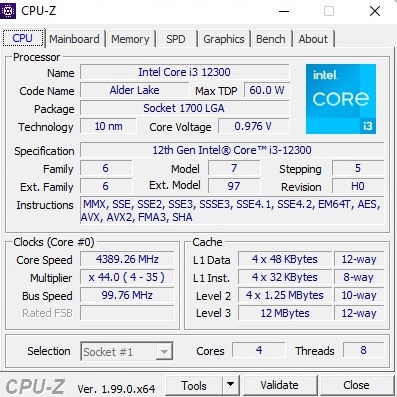
Intel Core i3-12300 CPU-Z screenshot, 4C/8T
Aside from architectural, core count, and thread count differences between the Intel Core i3-12300 and the AMD Ryzen 5 5600X, the next biggest difference is the price. The Ryzen 7 5600X has an MSRP of $299, although it can be found at Amazon at the time of writing for a recently trimmed price of $229. The Intel Core i3-12300 is much cheaper in contrast, with a per 1k unit pricing of $143. With the first shipments just now hitting the market, we expect the retail MSRP to be around the $160-170 mark.
Other processors from AMD that could be considered competitors are the 5000 series Cezanne APUs. This includes the Ryzen 5 5600G, which is currently $219 at Amazon. Despite being more focused on entry-level gaming with integrated Vega 7 graphics, it consists of six cores with a base frequency at 3.9 GHz and a turbo frequency of 4.4 GHz; the 5600G also benefits from twelve threads.
Finally, boxing things in from the other direction, Intel also has the Core i5-12600K processor with six P-cores and four E-cores, with a price tag of $280 at Newegg. We will be reviewing the Core i5 a bit later this month, and it is currently on our testbed undergoing our CPU test suite at the time of writing.
Test Bed and Setup
Although there were some initial problems with the Intel Thread Director when using Windows 10 at the launch of Alder Lake, the P-core only Core i3 stack doesn’t need to worry about this. For our testing, we are running the Core i3-12300 with DDR5 memory at JEDEC specifications for Alder Lake (DDR5-4800 CL40). We are also using Windows 11 from now on for our CPU reviews.
For our test bed, we are using the following:
| Alder Lake Test System (DDR5) | |
| CPU | Core i3-12300 ($143) 4+0 Cores, 8 Threads 60W Base, 89W Turbo |
| Motherboard | MSI Z690 Carbon WI-FI |
| Memory | SK Hynix 2×32 GB DDR5-4800 CL40 |
| Cooling | MSI Coreliquid 360mm AIO |
| Storage | Crucial MX300 1TB |
| Power Supply | Corsair HX850 |
| GPUs | NVIDIA RTX 2080 Ti, Driver 496.49 |
| Operating Systems | Windows 11 Up to Date |
All other chips for comparison were run as tests listed in our benchmark database, Bench, on Windows 10.
Since the launch of Intel’s Alder Lake-based 12th generation Core processors, there have been several reports of high and abnormal temperatures, even at stock frequencies. The art in balancing out the integrated heat spreader (IHS) of a processor is one thing extreme overclockers have been working on for many years now. Typically called lapping, extreme overclockers finely sand down the IHS to make it a more flat and even surface. The aim is to reduce gaps by sanding out imperfections or curvatures. This is so that the cooling plate of the CPU cooler makes better contact with the IHS, and it has been known to reduce CPU thermals by a decent amount.

Our Core i9-12900K IHS is ‘relatively’ flat and even.
Fellow enthusiast Igor Wallossek published an article on his website, Igorlabs.de, which investigates potential issues with the ILM (independent loading mechanism), which keeps the processor firmly in place within the socket. Doing some investigations myself, our testbed Core i9-12900K which we’ve used the most doesn’t seem to show any noticeable gaps or abnormal curvatures when used with a metal ruler. This, however, changes when we install the CPU into an LGA1700 socket or into one of the readily available Z690 motherboards.
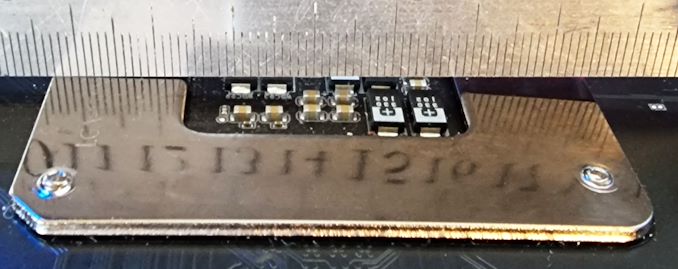
The rear of the Intel LGA1700 socket with Core i9-12900K installed
There have been many reports that installing an Alder Lake processor into one of the cheaper Z690 or B660 models causes the CPU socket to bend and the IHS itself. We saw no bending before installing our Alder Lake processor into the socket of the GIGABYTE Z690 Aorus Master, which is a premium board priced around $470. Installing the Core i9-12900K into the socket and locking the ILM into place, we saw noticeable bending on the rear of the board, as our picture above illustrates.
The implications of this are two-fold. Firstly, from a cooling standpoint, it will and can lead to increased thermals due to the gaps this creates between the cold plate of the cooler and the IHS on the CPU. While thermal paste will generally fill some of the gaps, the problem is the nature of the gap and its size that the increased pressure the ILM creates. The second and perhaps the most fundamental part of this, it should NOT be happening.
Buildzoid ‘rambles’ about the LGA1700 washer mod, a potential fix?
While PCBs can be flexible, the nature of heat creating further expansion could lead to damaged sockets damaged processors and ultimately leave users with an expensive headache. There’s also the potential to create permanent bends in the PCB area around the socket. This is not a good thing. It should be noted that LGA1700 motherboards either use ILM’s manufacturers by Lotes or Foxconn, but it’s reported that both ILMs are affected by this issue.
Fundamentally, there are a couple of potential workarounds to the issue, including a large, robust backplate. Still, on some of the AIO coolers, we have seen recently, these usually come with flimsy plastic backplates. Another potential fix is installing four washers to alleviate the issue. Both Igorlabs.de and Buildzoid have posted content detailing this, with Igor Wallossek doing some testing using washers of a different thickness to show variation.
Intel’s 12th generation processors from the top of the stack, including the flagship Core i9-12900K) and the more affordable and entry-level offerings such as the Core i3-12300, allow users to build a new system with the latest technologies available. One of the main elements that make Intel’s Alder Lake processors flexible for users building a new system is that it includes support for both DDR5 and DDR4 memory. It’s no secret that DDR5 memory costs (far) more than the already established DDR4 counterparts. One element to this includes an early adopter’s fee. Having the latest and greatest technology comes at a price premium.
The reason why we have opted to test the difference in performance between DDR5 and DDR4 memory with the Core i3-12300 is simply down to the price point. While users will most likely be looking to use DDR5 with the performance SKUs such as the Core i9-12900K, Core i7-12700K, and Core i5-12600K, users building a new system with the Core i3-12300 are more likely to go down a more affordable route. This includes using DDR4 memory, which is inherently cheaper than DDR5 and opting for a cheaper motherboard such as an H670, B660, or H610 option. Such systems do give up some performance versus what the i3-12300 can do at its peak, but in return it can bring costs down signfiicantly.
Traditionally we test our memory settings at JEDEC specifications. JEDEC is the standards body that determines the requirements for each memory standard. In the case of Intel’s Alder Lake, the Core i3 supports both DDR5 and DDR4 memory. Below are the memory settings we used for our DDR5 versus DDR4 testing:
- DDR4-3200 CL22
- DDR5-4800(B) CL40
CPU Performance: DDR5 versus DDR4

















In our computational benchmarks, there wasn’t much difference between DDR5-4800 CL40 and DDR4-3200 CL22 when using the Core i3-12300. The biggest difference came in our WinRAR benchmark which is heavily reliant on memory to increase performance; the DDR5 performed around 21% better than DDR4 in this scenario.
Gaming Performance: DDR5 versus DDR4












On the whole, DDR5 does perform better in our gaming tests, but not enough to make it a ‘must have’ in comparison to DDR4 memory. The gains overall are marginal for the most part, with DDR5 offering around 3-7 more frames per second over DDR4 memory, depending on the titles game engine optimization.
Our previous set of ‘office’ benchmarks have often been a mix of science and synthetics, so this time we wanted to keep our office section purely on real-world performance.
For the Core i3-12300, we are running DDR5 memory at the following settings:
- DDR5-4800(B) CL40
Power
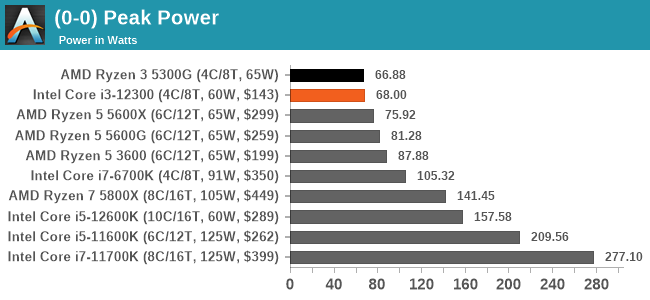
As expected from a 4C/8T processor, the Core i3-12300 has a lower power draw than the 6C/12T and 8C/16T models.
Office

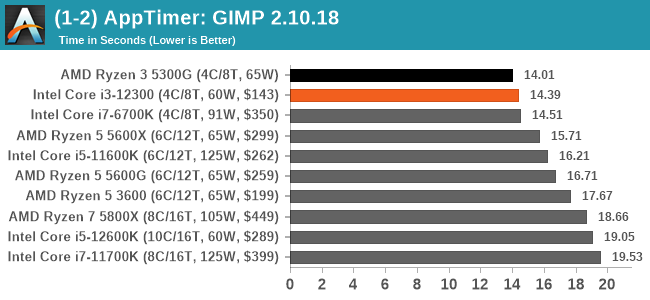
Compared to previous generations of Intel’s architecture, Alder Lake (Core i3-12300) is above everything else in regards to variable/lightly-threaded loads.
Science
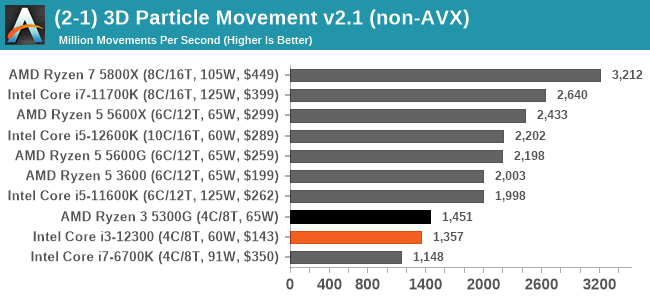
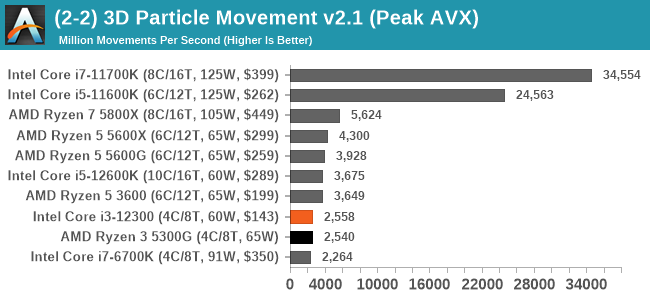
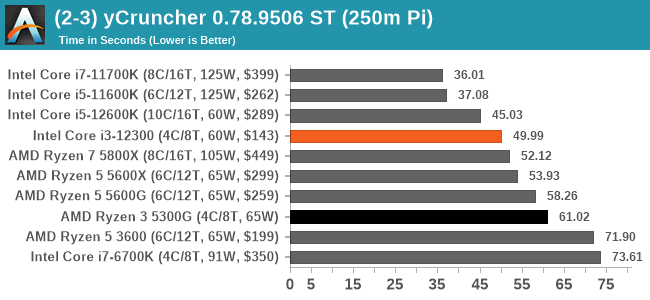
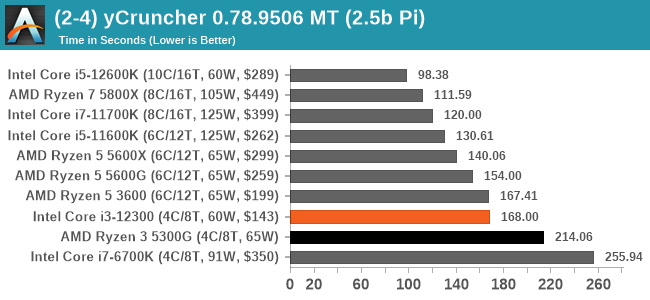

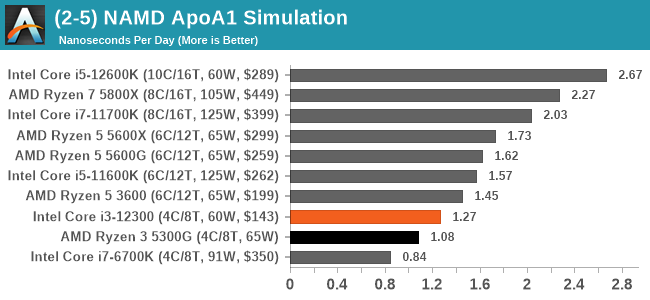

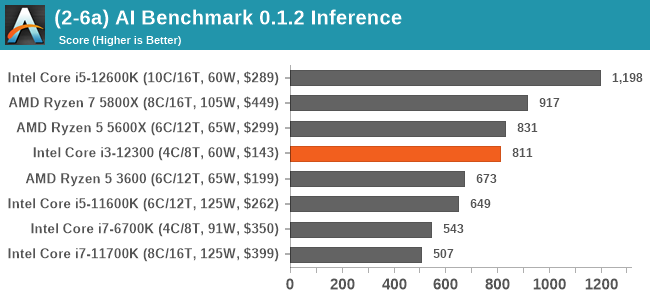
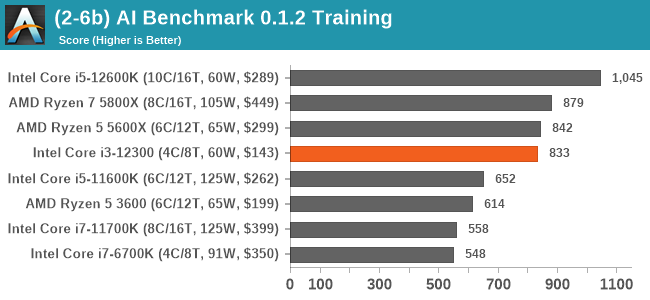
In any scenario where AVX-based workloads or in multi-core and multi-threaded applications, the Core i3-12300 lags behind the chips with higher core and thread count.
Simulation and Science have a lot of overlap in the benchmarking world, however for this distinction we’re separating into two segments mostly based on the utility of the resulting data. The benchmarks that fall under Science have a distinct use for the data they output – in our Simulation section, these act more like synthetics but at some level are still trying to simulate a given environment.
For the Core i3-12300, we are running DDR5 memory at the following settings:
- DDR5-4800(B) CL40
Simulation
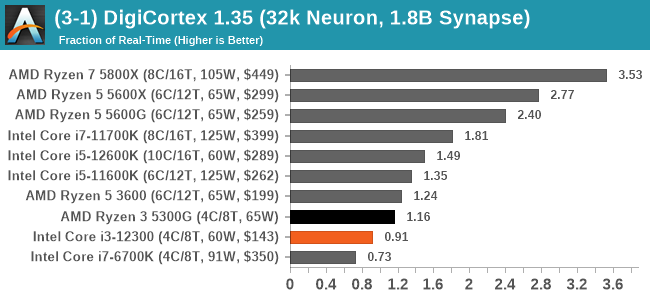
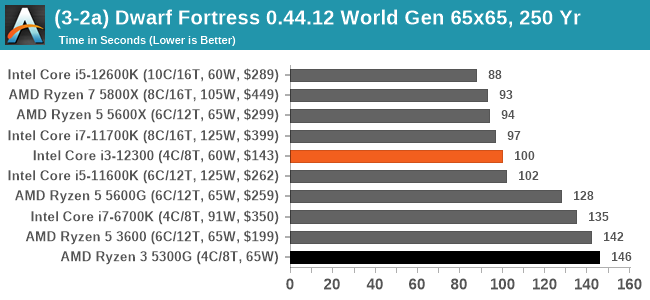
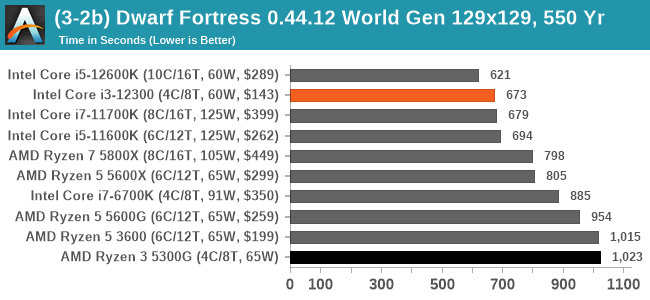
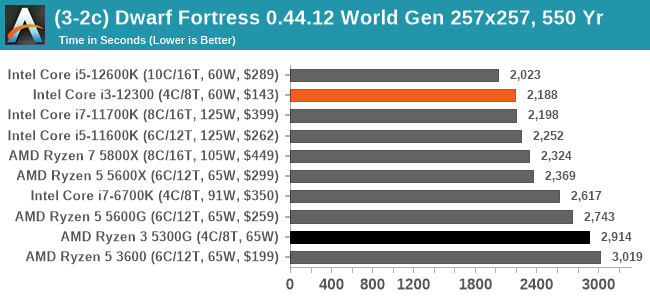
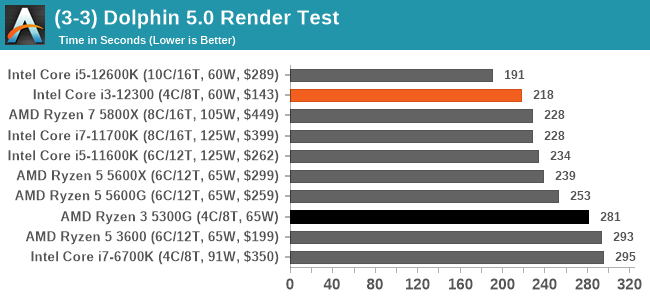

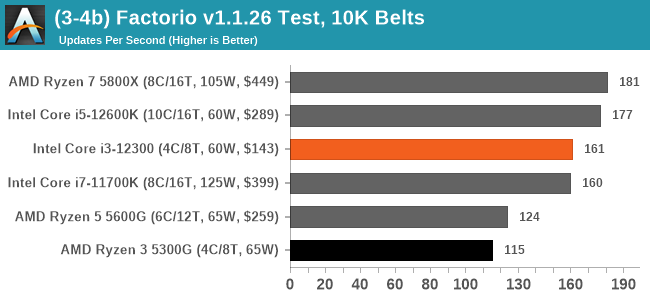
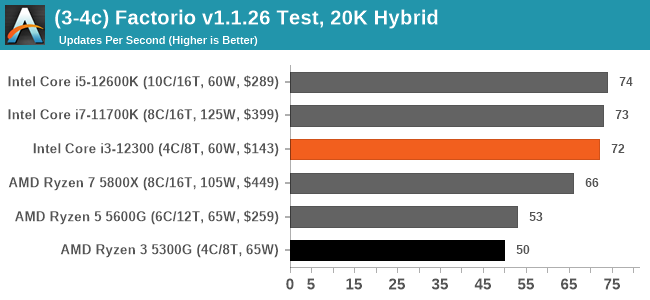
In tests that can utilize the higher IPC and lower core count, the Alder Lake i3 reigns supreme. The Core i3-12300 does struggle though in the tests that can really make use of a larger number of cores/threads.
Rendering

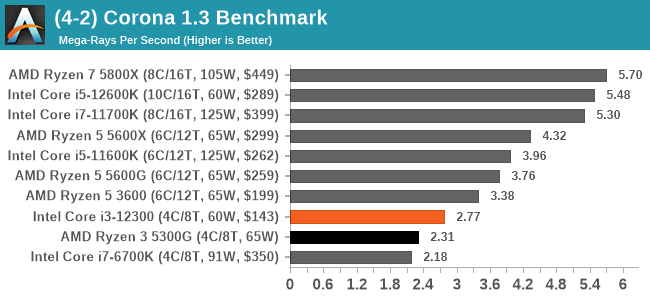
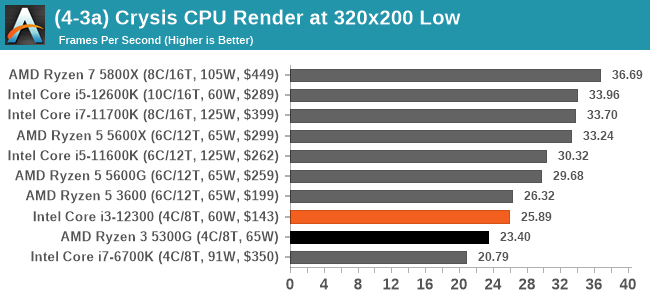


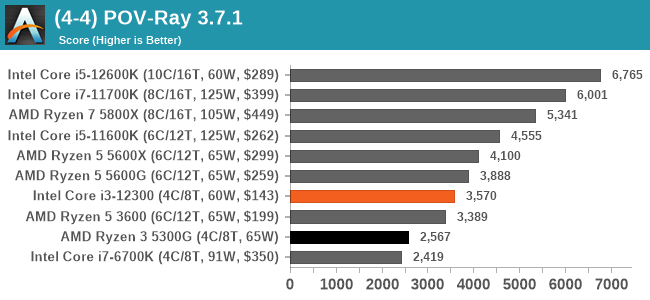
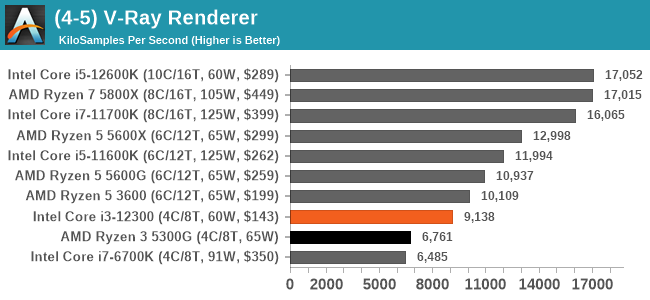
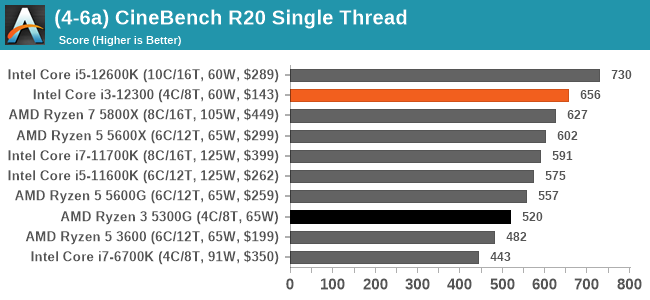

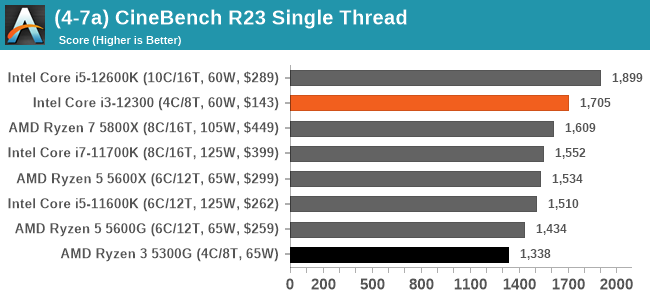
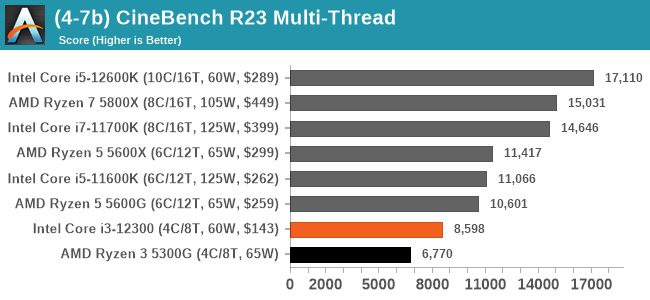
It’s clear that the Core i3-12300 doesn’t perform well in high core and thread situations such as rendering, although single-threaded performance is superb due to the Golden Cove-based P-cores.
One of the interesting elements on modern processors is encoding performance. This covers two main areas: encryption/decryption for secure data transfer, and video transcoding from one video format to another.
In the encrypt/decrypt scenario, how data is transferred and by what mechanism is pertinent to on-the-fly encryption of sensitive data – a process by which more modern devices are leaning to for software security.
Video transcoding as a tool to adjust the quality, file size and resolution of a video file has boomed in recent years, such as providing the optimum video for devices before consumption, or for game streamers who are wanting to upload the output from their video camera in real-time. As we move into live 3D video, this task will only get more strenuous, and it turns out that the performance of certain algorithms is a function of the input/output of the content.
For the Core i3-12300, we are running DDR5 memory at the following settings:
- DDR5-4800(B) CL40
Encoding
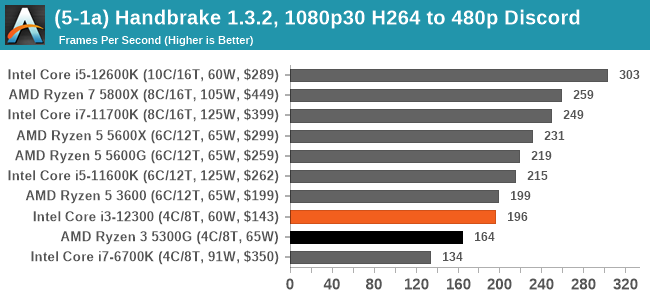
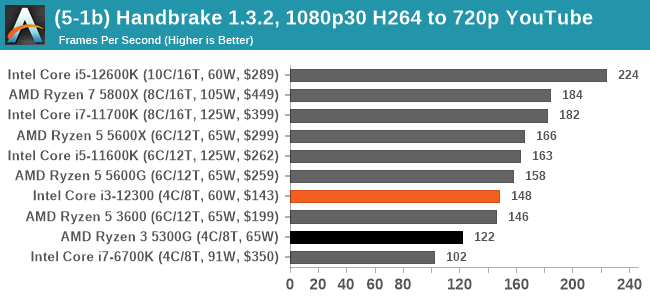
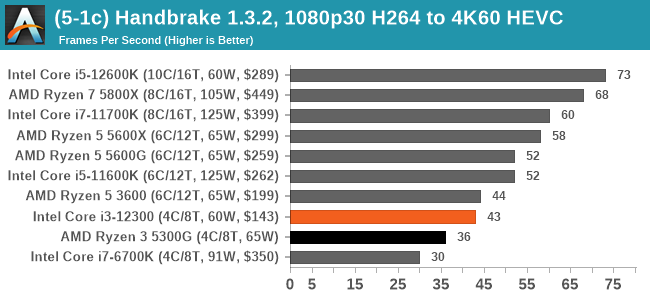

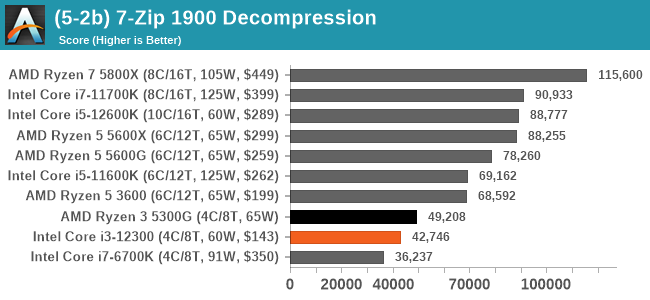
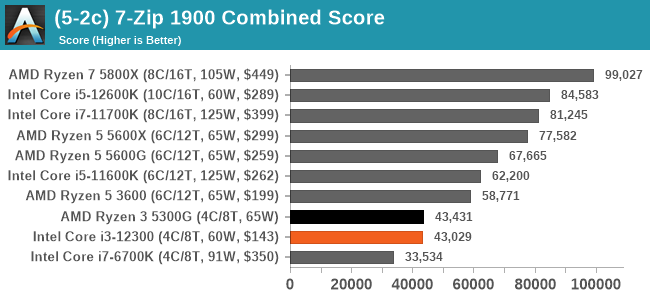
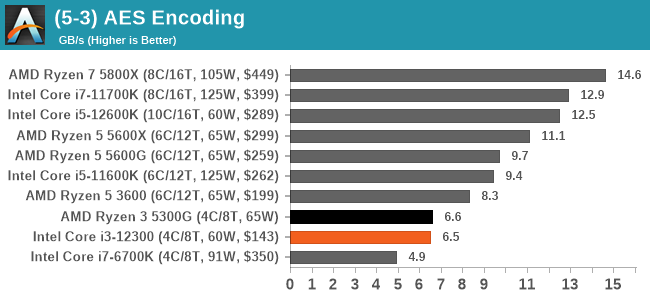

The Intel Core i3-12300 struggles compared with chips that have more cores and threads when it comes to encoding.
In order to gather data to compare with older benchmarks, we are still keeping a number of tests under our ‘legacy’ section. This includes all the former major versions of CineBench (R15, R11.5, R10) as well as x264 HD 3.0 and the first very naïve version of 3DPM v2.1. We won’t be transferring the data over from the old testing into Bench, otherwise it would be populated with 200 CPUs with only one data point, so it will fill up as we test more CPUs like the others.
The other section here is our web tests.
For the Core i3-12300, we are running DDR5 memory at the following settings:
- DDR5-4800(B) CL40
Legacy
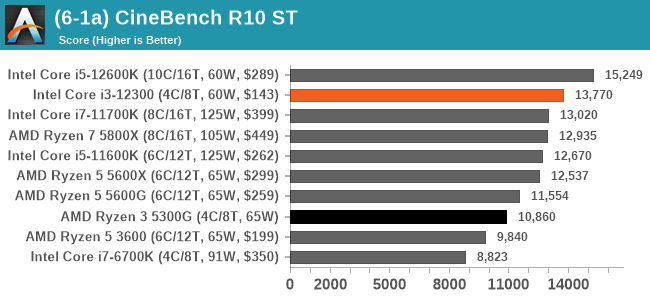

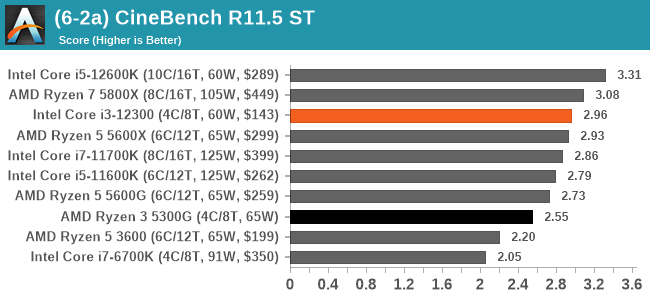
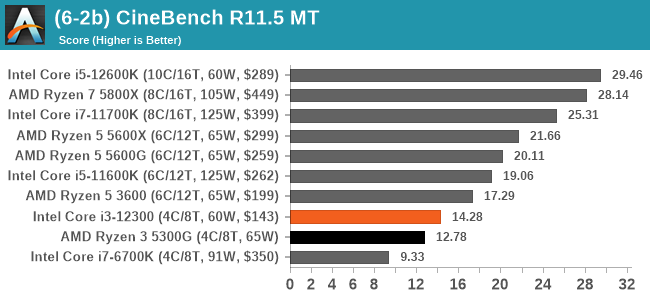
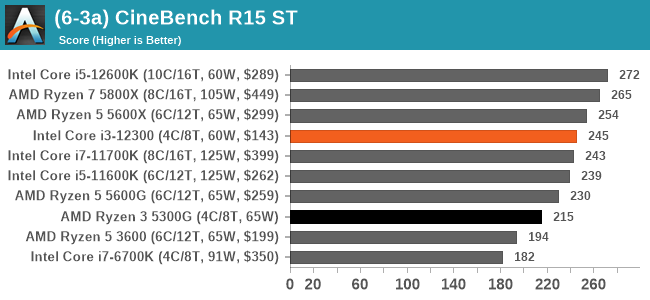
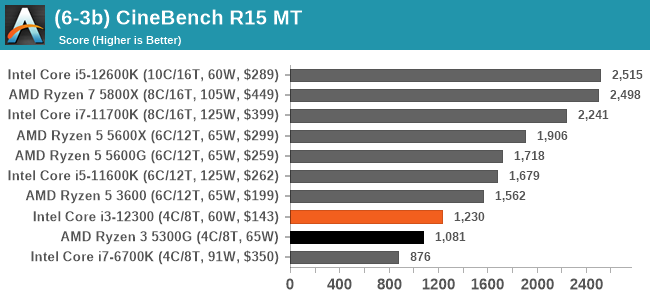
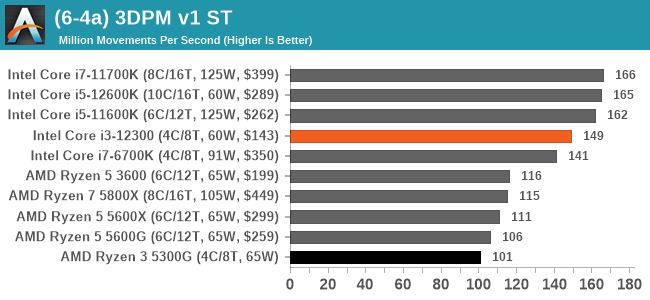

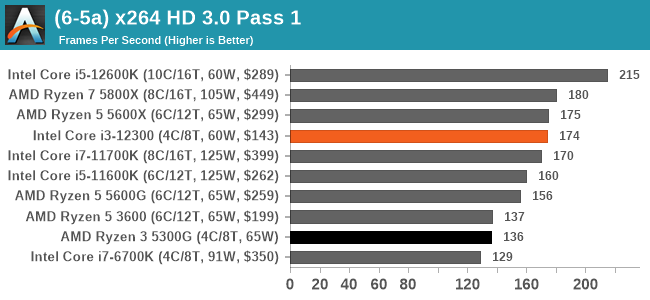
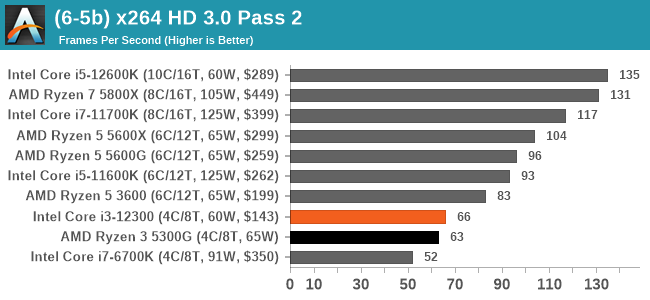
As we’ve seen throughout our testing, the Core i3-12300 does well in single-threaded performance. However, it does lack the grunt in multi-threaded applications compared with chips that feature more cores and threads.
Web
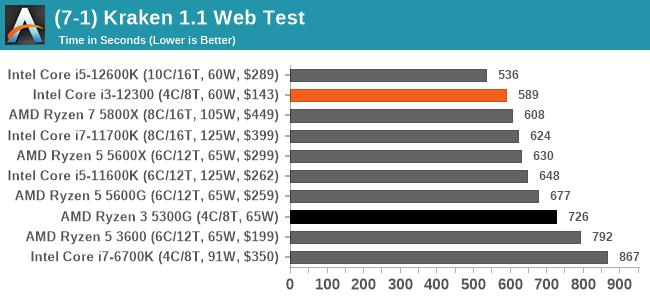


In our web-based benchmarks, the Core i3-12300 performs brilliantly due to the higher IPC performance of Intel’s Golden Cove P-cores on Alder Lake.
While a quad core processor is not going to be the first choice for gaming these days (especially when consoles have had 8 cores for the past two generations), 4 Golden Cove P cores still put up enough of a fight that the CPU is never too much of a limiting factor. Here we never drop below a 60fps average on any game.
All of our game testing results, including other resolutions, can be found in our benchmark database: www.anandtech.com/bench. All gaming tests were with an RTX 2080 Ti.
For the Core i3-12300, we are running DDR5 memory at the following settings:
- DDR5-4800(B) CL40
Civilization VI
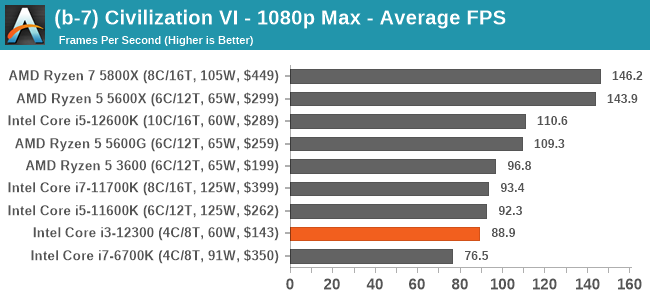
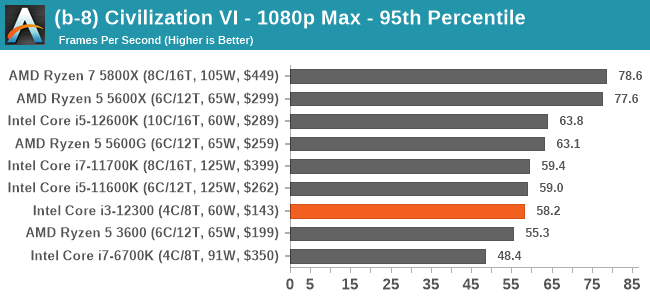
Deus Ex: Mankind Divided

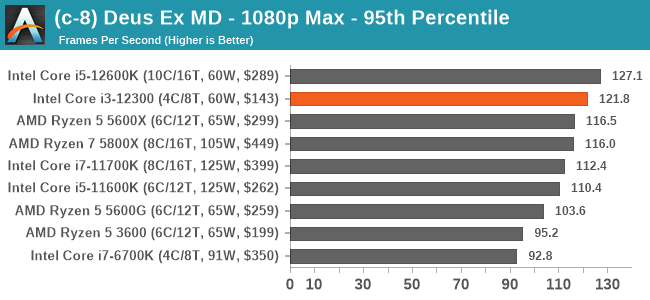
Final Fantasy 14
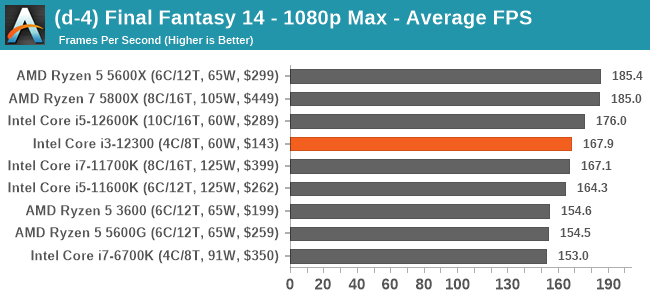
Final Fantasy 15
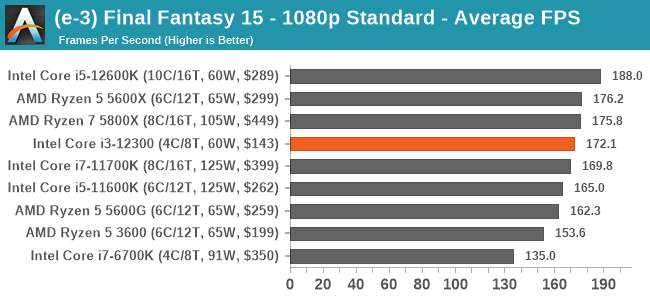
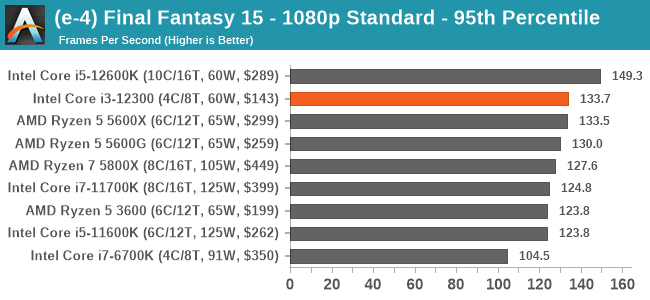
World of Tanks
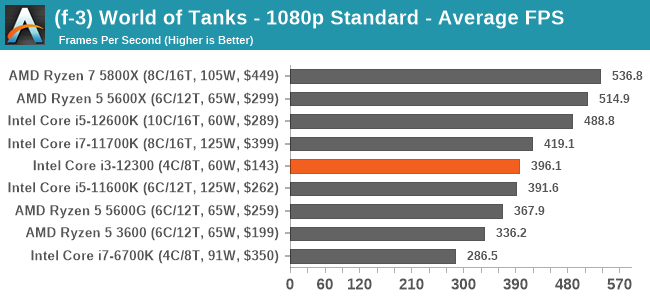
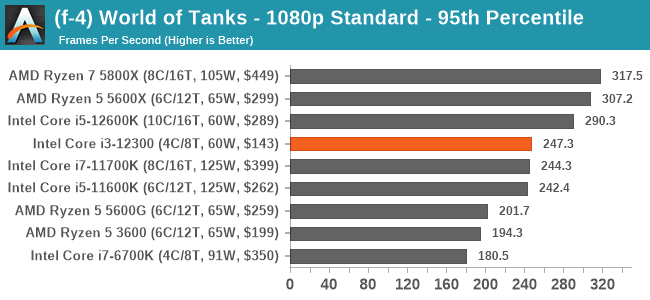
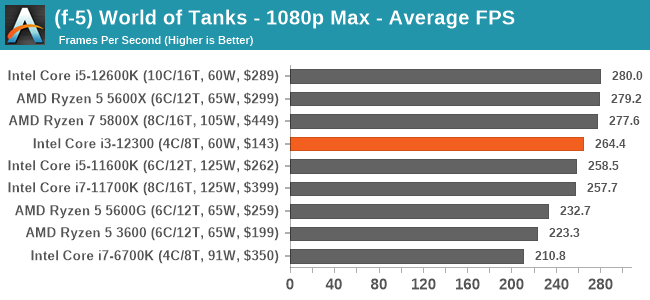
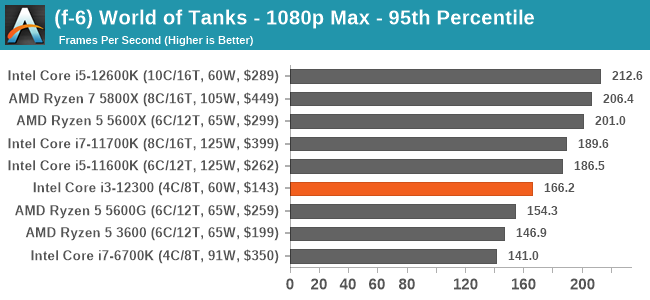
Borderlands 3

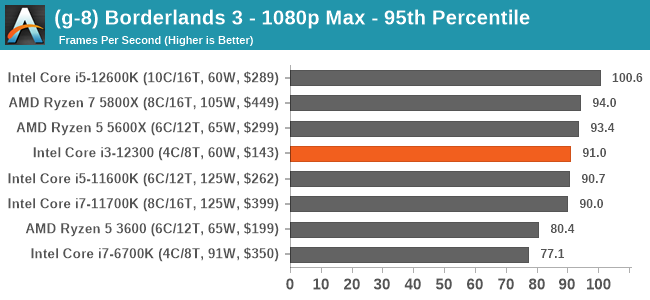
Far Cry 5
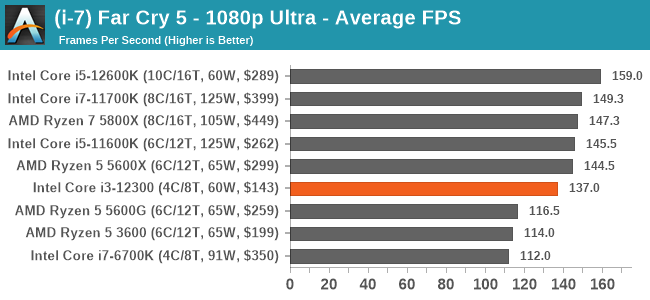

Gears Tactics
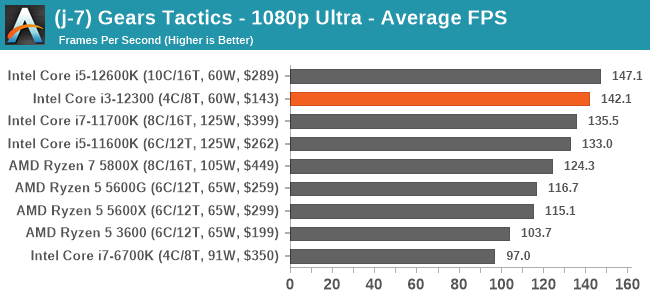
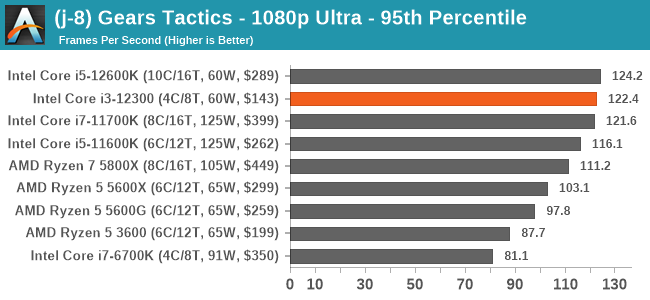
Grand Theft Auto V


Red Dead Redemption 2
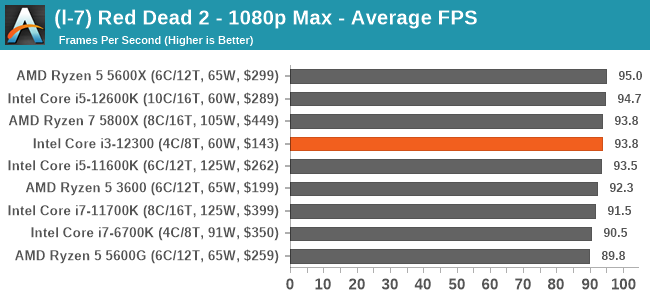
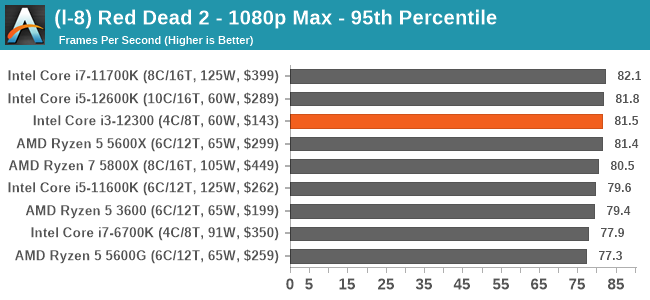
Strange Brigade (DirectX 12)
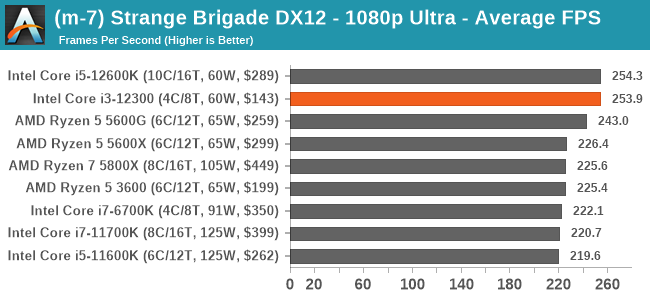
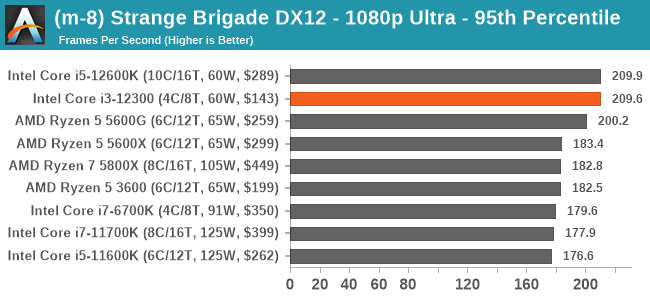
Strange Brigade (Vulcan)
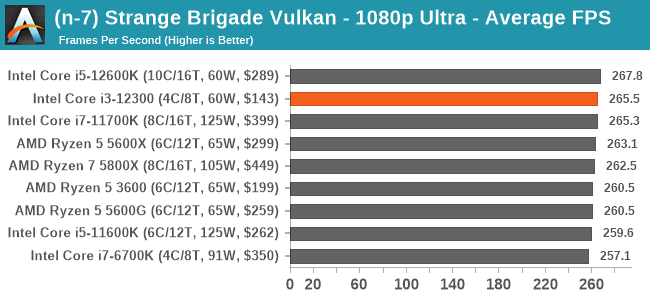

Over the last couple of years, AMD and Intel have been battling it out in the ‘core wars.’ The aim is to give users the largest core count – with many applications and games now benefiting from various multi-core optimizations – all for the best possible price. The other element of this fight has come down to IPC performance, with Intel and AMD flip-flopping for the top spot on its flagship desktop processors each time they both launch a new processor. Due to AMD’s Zen architectures, Intel has been on the ropes in both performance and value for a while. Intel has been forced to push its innovation and boundaries to try and maintain what it previously had; a majority market share.
As we highlighted in our launch day Core i9-12900K review, Intel’s new Alder Lake architecture brings new improvements and refinements to the table. This includes the two types of core, P-cores for performance and E-cores for efficiency/multi-threading. The P-cores are based on Intel’s Golden Cove architecture, with the aim of offering applications performance when it needs it. The E-cores, or efficiency cores as Intel depicts them, are lower power, and one E-core equates to roughly 50-60% of the performance of one P-Core.
Focusing on Intel’s Core i3-12300, it is the top SKU in its Core i3 lineup, with four P-cores, a base frequency of 3.5 GHz, and a turbo frequency of 4.4 GHz. In terms of power consumption, Intel has rated the i3-12300 at base frequencies with a TDP of 60 W and a 69 W TDP when at turbo clock speeds.
Intel’s interpretation of turbo on Alder Lake, which is essential from a power draw perspective, is ‘infinite turbo.’ This means the processor will try and use as much turbo as and when it can. Fundamentally from a performance perspective, this is good as it will hit turbo clock speeds more frequently, but ultimately, it makes power consumption particularly variable, depending on the workload.
Intel Core i3-12300: Performance Analysis
It’s all good and well having 16-core processors in a desktop platform, but ultimately, these typically cost upwards of $600. So what about CPUs for the more budget-conscious? Well, up until the launch of Intel’s 12th Gen Core processors, AMD’s Ryzen 5000 series had been at top of IPC, multi-threaded performance, and in a lot of scenarios, game performance and overall value too. One of AMD’s most cost-effective processors remains the Ryzen 5 5600X, with six cores, eight threads, and competitive clock speeds at a reasonable price of $229.
In budget CPU space, things have now changed with both of Intel’s Core i3 and i5 series slotting into that sub $300 market segment, with the Core i3 series significantly undercutting the 5600X in terms of price. In practice, Intel has the sub-$200 market entirely to itself right now, since AMD doesn’t have access to the manufacturing capacity needed to address that market (and thus compete directly with the i3-12300).
Another factor that comes into play is Alder Lake’s ability to support both DDR5 and DDR4 memory. We tested the Core i3-12300 with Windows 11 and DDR5-4800 CL40 memory for our Bench database data for comparative purposes. We did run tests with DDR5 4800 CL40 against DDR4-3200 CL22 on the Core i3-12300 on page 3, but the overall performance swing isn’t as big as users might think, at least not in the grand scheme of things.
Let’s take a look at some of the results and digest how the Intel Core i3-12300 stacks up against the competition:

Looking at single-threaded performance in Cinebench R23, the Core i3-12300 and the four Golden Cove P-cores show dominance over previous generations of Intel’s architecture, as well as AMD’s Zen 3 cores. This typically changes each time AMD or Intel releases a new desktop architecture, and right now, Intel’s 12th gen Core has the single-threaded crown.
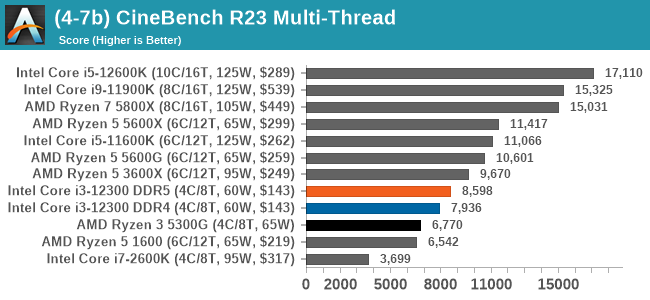
In the multi-threaded section of Cinebench R23, this is where the cores or lack thereof come into play. Both AMD’s Zen 3 6-core and 8-core processors have a considerable advantage in applications that can utilize all of the cores and threads available. Comparing DDR5 to DDR4 on the i3-12300, the DDR5-4800 CL40 performed around 8% better than DDR4-3200 CL22 in Cinebench R23’s multi-threaded test.
For a more classic comparison, we also have the Core i7-2600K, which released over 10 years ago, was one of the most popular quad core chips ever produced. Comparing it directly to the Core i3-12300, the (much) newer i3 performs 2.3x better in terms of multi-threaded performance.
The only real competitor in the 4C/8T segment from AMD with Zen 3 cores, is the Ryzen 3 5300G APU. In our computational benchmarks, the Core i3-12300 has a consistent and distinct advantage in both single-thread and multi-threaded performance. So even if AMD could produce those chips in retail volumes, at this point they’d come in behind Intel’s top quad.
Looking at other generational differences to AMD’s Ryzen 3000 and 1000 series chips, the Core i3-12300 comfortably beats the Zen-based Ryzen 5 1600 (6C/12T) processor. For reference, it is only 12.4% slower than the Zen 2 based Ryzen 5 3600X (6C/12T) processor in Cinebench R23 multi-threaded performance.

In our GTA V testing at 1080p at max settings with an NVIDIA RTX 2080 Ti, the Core i3-12300 is highly competitive with AMD’s Ryzen 5000 six and eight-core models. This includes Intel’s 11th generation processors, despite a lower core and thread count. The difference between DDR5 and DDR4 with the Core i3-12300 shows that using the platform with DDR5 memory was around 6% better in average frame rates over DDR4 when using Alder Lake’s JEDEC memory settings.
While gaming is subjective as different game engines are optimized differently for CPU core count, performance in GPU intensive titles shows the Core i3-12300 in a favorable light, thus making it competitive for 1080p gaming.

Looking at our Civilization VI benchmark performance at 1080p max settings, we see the limitations of where having a higher core count makes a substantial difference. Despite the 6C/12T and 8C/16T processors showing dominance, it’s worth noting that the Core i3-12300 is still comfortably performing above 60 fps in average frame rates, with the 95th percentile frame rates also hovering close to 60 fps.
Touching on DDR5 versus DDR4 with the i3-12300 and in a more CPU favorable test such as Civilization VI, the DDR5 configuration performed 3.7% better in terms of average frame rates. Not a lot of difference considering the current price premium DDR5 has attached at the moment, but it’s still an improvement nonetheless.
A broader selection of our CPU game testing results, including at other resolutions, can be found in our benchmark database: www.anandtech.com/bench. All gaming tests were with an RTX 2080 Ti for comparative purposes.
Intel Core i3-12300: Is Four Cores Enough in 2022?
The primary use case for Intel’s Core i3 series includes lower-powered desktops, where tasks such as video rendering, encoding, and other content-creation tasks either aren’t the target market, or are not the biggest use case for the market. As we’ve seen throughout our testing, the Intel Core i3-12300 is a fantastic processor for gamers on a budget, even with fewer cores than the competition, such as the Ryzen 5 5600 ($229), which is 6C/12T. You could say that the R5 5600X isn’t really a competitor due to the price, but Intel is slotting in its Core i3 series well below AMD Ryzen 5000’s entry point, and this makes things interesting.
| Intel Core i5 & i3 Processor Specifications (12th Gen Alder Lake) | ||||||||||
| AnandTech | Cores P+E |
P-Core Base |
P-Core Turbo |
E-Core Base |
E-Core Turbo |
L3 MB |
IGP | Base W |
Turbo W |
Price $1ku |
| i5-12600K | 6+4 | 3700 | 4900 | 2800 | 3600 | 20 | 770 | 125 | 150 | $289 |
| i5-12600KF | 6+4 | 3700 | 4900 | 2800 | 3600 | 20 | – | 125 | 150 | $264 |
| i5-12600 | 6+0 | 3300 | 4800 | – | – | 18 | 770 | 65 | 117 | $223 |
| i5-12600T | 6+0 | 2100 | 4600 | – | – | 18 | 770 | 35 | 74 | $223 |
| i5-12500 | 6+0 | 3000 | 4600 | – | – | 18 | 770 | 65 | 117 | $202 |
| i5-12500T | 6+0 | 2000 | 4400 | – | – | 18 | 770 | 35 | 74 | $202 |
| i5-12400 | 6+0 | 2500 | 4400 | – | – | 18 | 730 | 65 | 117 | $192 |
| i5-12400F | 6+0 | 2500 | 4400 | – | – | 18 | – | 65 | 117 | $167 |
| i5-12400T | 6+0 | 1800 | 4200 | – | – | 18 | 730 | 35 | 74 | $192 |
| i3-12300 | 4+0 | 3500 | 4400 | – | – | 12 | 730 | 60 | 89 | $143 |
| i3-12300T | 4+0 | 2300 | 4200 | – | – | 12 | 730 | 35 | 69 | $143 |
| i3-12100 | 4+0 | 3300 | 4300 | – | – | 12 | 730 | 60 | 89 | $122 |
| i3-12100F | 4+0 | 3300 | 4300 | – | – | 12 | – | 58 | 89 | $97 |
| i3-12100T | 4+0 | 2200 | 4100 | – | – | 12 | 730 | 35 | 69 | $122 |
Looking above at Intel’s 12th generation Core i5 and i3 processor stack, only the top two Core i5 models feature E-cores, the Core i5-12600K and Core i5-12600KF. Nothing below these in the stack comes with E-cores, and instead, rely on the fully-fledged P-cores (Golden Cove), with 6 cores for all the Core i5s and 4 cores for the Core i3 models.
Comparing the Core i3-12300 (4C/8T) to other 4C/8T and 6C/12T SKUs such as the AMD Ryzen 5 5600X (6C/12T), the Core i3 is very competitive overall, but it does show its limitations in multi-thread applications and scenarios. As users would generally expect to be the case, the Core i3-12300 is Intel’s most potent quad-core processor thus far. This isn’t a surprise as the i3-12300 benefits from the Intel 7 manufacturing process, as well as generational increases to IPC performance, base, and turbo frequencies.
The decision on whether or not it’s worth buying the Core i3-12300 over hex-core chips like the Ryzen 5 3600X or the Core i5-12600K comes down to the use case. Users planning on doing any form of rendering, encoding, or running multi-core optimized workloads will benefit from the extra cores and threads. Still, there’s not that much difference between the Core i3-12300 and Ryzen 5 3600X in regards to gaming, or in other workloads that can’t fill out more than 4 cores.
In gaming at 1080p and single-threaded applications, the Core i3-12300 excels and stakes its claim as a fantastic option for users on a budget. Looking further down the Alder Lake Core i3 stack, the Core i3-12100 ($122) could be the best value of the bunch, with a base frequency of 3.3 GHz and a turbo frequency of 4.3 GHz; just 100 MHz slower than the i3-12300. The onus is now on AMD to bring something competitive in the sub-$200 segment of the market, as right now, Intel holds all the marbles.
With an MSRP of $143, it’s clear that the Intel Core i3-12300 represents excellent value for money in a current market where users are struggling to find value in components. It is clear Alder Lake has been a success for Intel, and the Core i3-12300 offers leading-edge quad-core performance on desktop for an equally great price.

